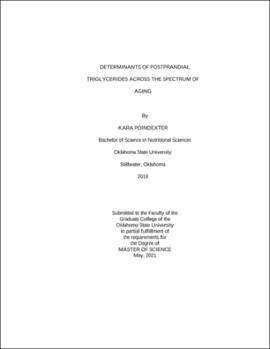| dc.description.abstract | Although elevated postprandial triglycerides (TG) are a risk factor for heart disease, and older adults exhibit greater postprandial lipemia (PPL) than younger adults, it is unknown how postprandial lipid tolerance changes as people age. This cross- sectional study examined postprandial TG responses across the aging spectrum and how this was influenced by lifestyle and risk factors. We recruited individuals evenly distributed between the ages of 50-89, with a balance of males and females. Participants completed diet and physical activity questionnaires, body composition and flow-mediated dilation (FMD) assessments, and an abbreviated fat tolerance test (AFTT). Following a 10-hour overnight fast, a blood draw was performed before and four hours after consumption of a high-fat meal (9 kcal/kg) to determine fasting and postprandial TG. Fifty-six participants (Age Groups: 50s n = 15; 60s n = 15; 70s n = 15; 80s n = 11) completed the study. Fasting TG across age groups did not differ (p=0.63; 50s: 99.7 +/- 50.1 mg/dL; 60s: 114.3 +/- 71.1 mg/dL; 70s: 102.9 +/- 45.0 mg/dL; 80s: 86.9 +/- 39.5 mg/dL). There was also no difference (p=0.40) in 4-hour TG across age groups (50s: 162.9 +/- 76.9 mg/dL; 60s: 181.9 +/- 99.9 mg/dL; 70s: 130.8 +/- 82.0 mg/dL; 80s: 130.8 +/- 60.6 mg/dL). FMD results did not differ across groups (50s: 4.06 +/- 1.88%; 60s: 4.21 +/- 1.60%; 70s: 3.23 +/- 1.68%; 80s: 3.53 +/- 1.23%). Moderate-to-vigorous physical activity minutes (MVPA) differed (p=0.01) across groups (50s: 190.5 +/- 46.07; 60s: 177.6 +/- 63.87; 70s: 135.8 +/- 41.88; 80s: 139 +/- 54.35). Variables significantly correlated with 4-hour TG included BMI, visceral adiposity, ALT, glucose, and alcohol. In Backward Elimination regression, the most predictive variables of 4-hour TG across age groups were postprandial glucose (p=0.01), ALT (p=0.007), and alcohol intake (p=0.04). Across four major decades (50s-80s), age and physical activity were not found to determine PPL. However, we identified ALT, postprandial glucose, and alcohol intake as key determinants of 4-hour TG. Future studies should aim to further understand the relationship between liver health, insulin resistance, alcohol intake, and PPL across the aging spectrum. | |
